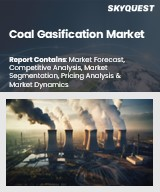
|
시장보고서
상품코드
1578979
세계의 석탄용 자연발화 억제제 시장 : 부문별 예측(2025-2030년)Spontaneous Combustion Inhibitors for Coal Market by Product Type (Additive Powders, Gel, Granule Inhibitors), Technology (Injection Systems, Spray Technology), End-Use Industry, Application - Global Forecast 2025-2030 |
||||||
석탄용 자연발화 억제제(Spontaneous Combustion Inhibitors for Coal) 시장은 2023년 2억 6,329만 달러로 평가되었고, 2024년에는 2억 7,519만 달러에 이를 것으로 추정되며, CAGR 5.47%로 성장하며 2030년에는 3억 8,239만 달러에 달할 것으로 예측됩니다.
석탄의 자연발화는 심각한 위험을 초래하므로 자연발화 억제제의 개발과 사용이 필요합니다. 이러한 억제제의 범위는 주위 온도에서 산화되는 고유의 탄소질 원소와 황철광 원소에 의한 석탄의 발화를 방지하기 위한 화학적 치료 및 제어 방법을 포함합니다. 그 응용은 석탄의 저장과 운송이 활발한 산업에서 필수적이며 채굴 사업, 발전소, 석탄 저장 시설의 위험을 줄입니다. 그 필요성은 안전성을 높이고 경제적 손실을 줄이고 화재 및 독성 물질의 배출로 인한 환경에 미치는 영향을 억제하는 긴급성으로 인해 발생합니다. 시장 성장의 원동력은 석탄 생산 증가, 엄격한 안전 및 환경 규제, 화학 기술 진보입니다. 그러나 억제제의 막대한 비용, 일부 지역에서 인식 부족, 재생 가능 에너지원으로의 시프트에 의한 석탄 의존도의 저하 등 요인이 성장의 과제가 되고 있습니다. 이러한 과제에도 불구하고 환경 친화적이고 비용 효과적인 억제제 개발, 저장 및 해상 운송에서 용도 확대, 실시간 연소 방지를 목적으로 한 디지털 모니터링 시스템 강화 등 기회가 풍부하게 있습니다. 시장의 발전에 따라 생분해성 억제제의 배합이나 보다 스마트한 안전 관리를 위한 IoT와의 통합에 혁신이 기다리고 있습니다. 또한, 다른 탄종과 환경 조건에 맞는 억제제를 조사하면 경쟁 우위를 가져올 수 있습니다. 이 시장은 화학 제조 업체, 기술 기업 및 학술 기관이 협력하여 최첨단 솔루션을 개척하기위한 비옥 한 토양을 제공합니다. 그러나 기업은 지역에 따라 크게 다른 규제 준수나 환경 기준 등 복잡한 문제를 극복해야 합니다. 자연발화억제제 시장은 변화하는 정세를 나타내고 있으며, 적극적인 적응과 지속적인 혁신이 새로운 기회를 활용하고 성장 장벽을 회피하는데 있어서 매우 중요합니다.
| 주요 시장 통계 | |
|---|---|
| 기준연도(2023년) | 2억 6,329만 달러 |
| 추정연도(2024년) | 2억 7,519만 달러 |
| 예측연도(2030년) | 3억 8,239만 달러 |
| CAGR(%) | 5.47% |
시장 역학 : 급속히 진화하는 석탄용 자연발화 억제제의 시장 주요 인사이트 공개
석탄용 자연발화 억제제 시장은 수요 및 공급의 역동적인 상호작용에 의해 변모를 이루고 있습니다. 이러한 시장 역학의 진화를 이해함으로써 기업은 충분한 정보를 바탕으로 투자결정, 전략적 결정 정밀화, 새로운 비즈니스 기회 획득에 대비할 수 있습니다. 이러한 동향을 종합적으로 파악함으로써 기업은 정치적, 지리적, 기술적, 사회적, 경제적 영역에 걸친 다양한 리스크를 경감할 수 있을 뿐만 아니라, 소비자 행동과 그것이 제조 비용 또는 구매 동향에 미치는 영향을보다 명확하게 이해할 수 있습니다.
- 시장 성장 촉진요인
- 에너지 수요의 증대에 의한 석탄 소비량 증가와 자연발화 완화의 필요성
- 환경 규제의 강화가 발전소에서 석탄 자연발화 억제제의 채택을 촉진
- 세계 에너지 가격 상승으로 석탄의 효율적인 이용과 자연발화 억제에 대한 주목 확대
- 시장 성장 억제요인
- 현대산업에서 석탄용 자연발화 억제제의 세계가 직면하는 제약의 검증
- 세계의 석탄 산업에 있어서 자연발화 억제제의 채택 장벽의 분석
- 시장 기회
- 석탄 산업의 혁신적인 자연발화 억제제의 국제 수요 분석
- 기술 진보가 석탄 자연발화 억제제의 효과를 높여, 위험성을 저감
- 시장 과제
- 석탄 자연발화 억제제의 전개에 있어서 다양한 기술적·물류적 과제 분석
- 석탄 연소 방지 기술에서 공급망 관리의 복잡성을 탐구
Porter's Five Forces : 석탄용 자연발화 억제제 시장을 탐색하는 전략 도구
Porter's Five Forces 프레임워크는 시장 상황경쟁 구도를 이해하는 중요한 도구입니다. Porter's Five Forces 프레임워크는 기업의 경쟁력을 평가하고 전략적 기회를 탐구하는 명확한 기술을 제공합니다. 이 프레임워크는 기업이 시장 내 세력도를 평가하고 신규 사업의 수익성을 판단하는 데 도움이 됩니다. 이러한 통찰을 통해 기업은 자사의 강점을 활용하고, 약점을 해결하고, 잠재적인 과제를 피할 수 있으며, 보다 강인한 시장에서 포지셔닝을 보장할 수 있습니다.
PESTLE 분석 : 석탄용 자연발화 억제제 시장에서 외부로부터 영향 파악
외부 거시환경요인은 석탄용 자연발화 억제제의 시장 실적 역학을 형성하는데 있어 매우 중요한 역할을 합니다. 정치적, 경제적, 사회적, 기술적, 법적, 환경적 요인 분석은 이러한 영향을 탐색하는 데 필요한 정보를 제공합니다. PESTLE 요인을 조사함으로써 기업은 잠재적인 위험과 기회를 더 잘 이해할 수 있습니다. 이 분석을 통해 기업은 규제, 소비자 선호, 경제 동향의 변화를 예측하고 앞으로 예상되는 적극적인 의사 결정을 할 준비를 할 수 있습니다.
시장 점유율 분석 : 석탄용 자연발화 억제제 시장에서 경쟁 구도 파악
석탄용 자연발화 억제제 시장에 대한 상세한 시장 점유율 분석을 통해 공급업체의 성과를 종합적으로 평가할 수 있습니다. 기업은 수익, 고객 기반, 성장률 등 주요 지표를 비교하여 경쟁 포지셔닝을 밝힐 수 있습니다. 이 분석을 통해 시장 집중, 단편화, 통합 동향을 밝혀내고 벤더들은 경쟁이 치열해지는 가운데 자사의 지위를 높이는 전략적 의사 결정을 내리는 데 필요한 지식을 얻을 수 있습니다.
FPNV 포지셔닝 매트릭스 : 석탄용 자연발화 억제제 시장에서 공급업체의 성과 평가
FPNV 포지셔닝 매트릭스는 석탄용 자연발화 억제제 시장에서 공급업체를 평가하는 중요한 도구입니다. 이 매트릭스를 통해 비즈니스 조직은 공급업체의 비즈니스 전략과 제품 만족도를 기준으로 평가하여 목표에 맞는 충분한 정보를 바탕으로 의사 결정을 내릴 수 있습니다. 네 가지 사분면을 통해 공급업체를 명확하고 정확하게 부문화하고 전략 목표에 가장 적합한 파트너 및 솔루션을 파악할 수 있습니다.
전략 분석 및 추천 : 석탄용 자연발화 억제제의 시장에서 성공에 대한 길
석탄용 자연발화 억제제의 시장의 전략분석은 시장에서 입지 강화를 목표로 하는 기업에 있어서 필수적입니다. 주요 자원, 역량 및 성과 지표를 검토함으로써 기업은 성장 기회를 파악하고 개선을 위해 노력할 수 있습니다. 이러한 접근 방식을 통해 경쟁 구도에서 과제를 극복하고 새로운 비즈니스 기회를 활용하여 장기적인 성공을 거둘 수 있는 체제를 구축할 수 있습니다.
이 보고서는 주요 관심 분야를 포괄하는 시장의 종합적인 분석을 제공합니다.
1. 시장 침투 : 현재 시장 환경의 상세한 검토, 주요 기업의 광범위한 데이터, 시장 도달범위 및 전반적인 영향력을 평가합니다.
2. 시장 개척도 : 신흥 시장 성장 기회를 파악하고 기존 분야의 확장 가능성을 평가하며 미래 성장을 위한 전략적 로드맵을 제공합니다.
3. 시장 다양화 : 최근 제품 시장, 미개척 지역, 업계의 주요 진보, 시장을 형성하는 전략적 투자를 분석합니다.
4. 경쟁 평가 및 정보 : 경쟁 구도를 철저히 분석하여 시장 점유율, 사업 전략, 제품 포트폴리오, 인증, 규제 당국 승인, 특허 동향, 주요 기업의 기술 진보 등을 검증합니다.
5. 제품 개발 및 혁신 : 미래 시장 성장을 가속할 것으로 예상되는 최첨단 기술, R&D 활동, 제품 혁신을 강조합니다.
또한 이해관계자가 충분한 정보를 얻고 의사결정을 할 수 있도록 중요한 질문에 대답하고 있습니다.
1. 현재 시장 규모와 향후 성장 예측은?
2. 최고의 투자 기회를 제공하는 제품, 부문 및 지역은?
3. 시장을 형성하는 주요 기술 동향과 규제의 영향은?
4. 주요 벤더의 시장 점유율과 경쟁 포지션은?
5. 벤더 시장 진입·철수 전략의 원동력이 되는 수익원과 전략적 기회는?
목차
제1장 서문
제2장 조사 방법
제3장 주요 요약
제4장 시장 개요
제5장 시장 인사이트
- 시장 역학
- 성장 촉진요인
- 에너지 수요가 증가함에 따라 석탄 소비량이 증가하고 자연발화 완화의 필요성이 증가
- 환경 규제의 강화에 의해 발전소에서 석탄 자연발화 억제제의 도입이 진행
- 세계 에너지 가격 상승으로 석탄의 효율적인 이용과 자연발화 제어에 대한 주목 확대
- 억제요인
- 현대의 산업에 있어서 석탄용 자연발화 억제제의 세계의 한계를 검증
- 세계의 석탄 산업에 있어서 자연발화 억제제의 도입 장벽의 분석
- 기회
- 석탄산업에 있어서 혁신적인 자연발화 억제제의 국제적 수요의 분석
- 기술 진보에 의해 석탄 자연발화 억제제의 유효성이 향상되어 위험성이 경감
- 과제
- 석탄 자연발화 억제제의 도입에 있어서 다양한 기술적 및 물류상의 과제 분석
- 석탄 연소 방지 기술에서 공급망 관리의 복잡성을 탐구
- 성장 촉진요인
- 시장 세분화 분석
- Porter's Five Forces 분석
- PESTEL 분석
- 정치적
- 경제적
- 사회적
- 기술적
- 법적
- 환경적
제6장 석탄용 자연발화 억제제 시장 : 제품 유형별
- 첨가제 분말
- 겔
- 과립 억제제
- 액체 억제제
제7장 석탄용 자연발화 억제제 시장 : 기술별
- 분사 시스템
- 스프레이 기술
- 에어로졸 스프레이
- 공압 스프레이
제8장 석탄용 자연발화 억제제 시장 : 최종 용도 산업별
- 시멘트 제조
- 화학처리
- 석탄 채굴
- 노천 채굴 작업
- 지하 채굴 작업
- 발전
- 석탄화력발전소
- 신재생에너지 솔루션
- 철강 생산
- 고로 조업
- 전기로 조작
제9장 석탄용 자연발화 억제제 시장 : 용도별
- 연소 후 억제
- 보일러 시스템
- 가마
- 연소 전 억제
- 석탄 저장
- 석탄 수송
제10장 아메리카의 석탄용 자연발화 억제제 시장
- 아르헨티나
- 브라질
- 캐나다
- 멕시코
- 미국
제11장 아시아 태평양의 석탄용 자연발화 억제제 시장
- 호주
- 중국
- 인도
- 인도네시아
- 일본
- 말레이시아
- 필리핀
- 싱가포르
- 한국
- 대만
- 태국
- 베트남
제12장 유럽·중동 및 아프리카의 석탄용 자연발화 억제제 시장
- 덴마크
- 이집트
- 핀란드
- 프랑스
- 독일
- 이스라엘
- 이탈리아
- 네덜란드
- 나이지리아
- 노르웨이
- 폴란드
- 카타르
- 러시아
- 사우디아라비아
- 남아프리카공화국
- 스페인
- 스웨덴
- 스위스
- 터키
- 아랍에미리트(UAE)
- 영국
제13장 경쟁 구도
- 시장 점유율 분석(2023년)
- FPNV 포지셔닝 매트릭스(2023년)
- 경쟁 시나리오 분석
- 전략 분석 및 제안
기업 목록
- 3M Company
- AkzoNobel NV
- Albemarle Corporation
- Arkema Group
- Arrow Chemical Group Corp.
- Ashland Global Holdings Inc.
- Baker Hughes cOMPANY
- BASF SE
- Clariant AG
- Dow Corning Corporation
- Dow Inc.
- Eastman Chemical Company
- Ecolab Inc.
- Evonik Industries AG
- Huntsman Corporation
- Imerys SA
- Kemira Oyj
- LANXESS AG
- Nippon Ketjen Co., Ltd.
- PPG Industries, Inc.
- Quaker Houghton
- Reolube
- Sasol Limited
- Solvay SA
- Univar Solutions Inc.
The Spontaneous Combustion Inhibitors for Coal Market was valued at USD 263.29 million in 2023, expected to reach USD 275.19 million in 2024, and is projected to grow at a CAGR of 5.47%, to USD 382.39 million by 2030.
The spontaneous combustion of coal poses significant hazards, necessitating the development and use of spontaneous combustion inhibitors. The scope of these inhibitors encompasses chemical treatments and control methods to prevent coal from igniting due to inherent carbonaceous and pyritic elements that oxidize at ambient temperatures. Their application is essential in industries where coal storage and transportation are prevalent, reducing risks for mining operations, power plants, and coal storage facilities. The necessity arises from the urgency to enhance safety, reduce financial losses, and curb environmental impacts stemming from fires and toxic emissions. Market growth is driven by increasing coal production, stringent safety and environmental regulations, and advances in chemical technologies. However, growth is challenged by factors such as the high cost of inhibitors, lack of awareness in some regions, and the shift towards renewable energy sources reducing coal dependency. Despite these challenges, opportunities abound in developing eco-friendly and cost-effective inhibitors, expanding applications in storage and marine transportation, and enhancing digital monitoring systems for real-time combustion prevention. As the market evolves, innovations await in the formulation of biodegradable inhibitors and integration with IoT for smarter safety management. Furthermore, research into inhibitors tailored to different coal types and environmental conditions could offer competitive advantages. The market provides fertile ground for collaboration between chemical manufacturers, technology firms, and academic institutions to pioneer cutting-edge solutions. Yet, companies must navigate complexities such as regulatory compliance and environmental standards, which vary drastically across regions. The spontaneous combustion inhibitors market exhibits a shifting landscape, where proactive adaptation and continuous innovation are pivotal for capitalizing on emerging opportunities and circumventing growth barriers.
| KEY MARKET STATISTICS | |
|---|---|
| Base Year [2023] | USD 263.29 million |
| Estimated Year [2024] | USD 275.19 million |
| Forecast Year [2030] | USD 382.39 million |
| CAGR (%) | 5.47% |
Market Dynamics: Unveiling Key Market Insights in the Rapidly Evolving Spontaneous Combustion Inhibitors for Coal Market
The Spontaneous Combustion Inhibitors for Coal Market is undergoing transformative changes driven by a dynamic interplay of supply and demand factors. Understanding these evolving market dynamics prepares business organizations to make informed investment decisions, refine strategic decisions, and seize new opportunities. By gaining a comprehensive view of these trends, business organizations can mitigate various risks across political, geographic, technical, social, and economic domains while also gaining a clearer understanding of consumer behavior and its impact on manufacturing costs and purchasing trends.
- Market Drivers
- Growing demand for energy leads to increased coal consumption and need for spontaneous combustion mitigation
- Stricter environmental regulations drive the adoption of coal combustion inhibitors in power plants
- Rising global energy prices heighten focus on efficient coal utilization and spontaneous combustion control
- Market Restraints
- Examining the limitations faced by spontaneous combustion inhibitors for coal in modern industries
- Analyzing the barriers to adoption of spontaneous combustion inhibitors in global coal industries
- Market Opportunities
- Analyzing international demand for innovative spontaneous combustion inhibitors in coal industries
- Technological advancements enhance the effectiveness of coal combustion inhibitors reducing hazards
- Market Challenges
- Analyzing the diverse technological and logistical challenges in deploying coal combustion inhibitors
- Exploring the complexities of supply chain management in coal combustion prevention technologies
Porter's Five Forces: A Strategic Tool for Navigating the Spontaneous Combustion Inhibitors for Coal Market
Porter's five forces framework is a critical tool for understanding the competitive landscape of the Spontaneous Combustion Inhibitors for Coal Market. It offers business organizations with a clear methodology for evaluating their competitive positioning and exploring strategic opportunities. This framework helps businesses assess the power dynamics within the market and determine the profitability of new ventures. With these insights, business organizations can leverage their strengths, address weaknesses, and avoid potential challenges, ensuring a more resilient market positioning.
PESTLE Analysis: Navigating External Influences in the Spontaneous Combustion Inhibitors for Coal Market
External macro-environmental factors play a pivotal role in shaping the performance dynamics of the Spontaneous Combustion Inhibitors for Coal Market. Political, Economic, Social, Technological, Legal, and Environmental factors analysis provides the necessary information to navigate these influences. By examining PESTLE factors, businesses can better understand potential risks and opportunities. This analysis enables business organizations to anticipate changes in regulations, consumer preferences, and economic trends, ensuring they are prepared to make proactive, forward-thinking decisions.
Market Share Analysis: Understanding the Competitive Landscape in the Spontaneous Combustion Inhibitors for Coal Market
A detailed market share analysis in the Spontaneous Combustion Inhibitors for Coal Market provides a comprehensive assessment of vendors' performance. Companies can identify their competitive positioning by comparing key metrics, including revenue, customer base, and growth rates. This analysis highlights market concentration, fragmentation, and trends in consolidation, offering vendors the insights required to make strategic decisions that enhance their position in an increasingly competitive landscape.
FPNV Positioning Matrix: Evaluating Vendors' Performance in the Spontaneous Combustion Inhibitors for Coal Market
The Forefront, Pathfinder, Niche, Vital (FPNV) Positioning Matrix is a critical tool for evaluating vendors within the Spontaneous Combustion Inhibitors for Coal Market. This matrix enables business organizations to make well-informed decisions that align with their goals by assessing vendors based on their business strategy and product satisfaction. The four quadrants provide a clear and precise segmentation of vendors, helping users identify the right partners and solutions that best fit their strategic objectives.
Strategy Analysis & Recommendation: Charting a Path to Success in the Spontaneous Combustion Inhibitors for Coal Market
A strategic analysis of the Spontaneous Combustion Inhibitors for Coal Market is essential for businesses looking to strengthen their global market presence. By reviewing key resources, capabilities, and performance indicators, business organizations can identify growth opportunities and work toward improvement. This approach helps businesses navigate challenges in the competitive landscape and ensures they are well-positioned to capitalize on newer opportunities and drive long-term success.
Key Company Profiles
The report delves into recent significant developments in the Spontaneous Combustion Inhibitors for Coal Market, highlighting leading vendors and their innovative profiles. These include 3M Company, AkzoNobel N.V., Albemarle Corporation, Arkema Group, Arrow Chemical Group Corp., Ashland Global Holdings Inc., Baker Hughes cOMPANY, BASF SE, Clariant AG, Dow Corning Corporation, Dow Inc., Eastman Chemical Company, Ecolab Inc., Evonik Industries AG, Huntsman Corporation, Imerys S.A., Kemira Oyj, LANXESS AG, Nippon Ketjen Co., Ltd., PPG Industries, Inc., Quaker Houghton, Reolube, Sasol Limited, Solvay SA, and Univar Solutions Inc..
Market Segmentation & Coverage
This research report categorizes the Spontaneous Combustion Inhibitors for Coal Market to forecast the revenues and analyze trends in each of the following sub-markets:
- Based on Product Type, market is studied across Additive Powders, Gel, Granule Inhibitors, and Liquid Inhibitors.
- Based on Technology, market is studied across Injection Systems and Spray Technology. The Spray Technology is further studied across Aerosol Sprays and Pneumatic Sprays.
- Based on End-Use Industry, market is studied across Cement Manufacturing, Chemical Processing, Coal Mining, Power Generation, and Steel Production. The Coal Mining is further studied across Surface Mining Operations and Underground Mining Operations. The Power Generation is further studied across Coal-Fired Power Plants and Renewable Energy Solutions. The Steel Production is further studied across Blast Furnace Operations and Electric Arc Furnace Operations.
- Based on Application, market is studied across Post-Combustion Inhibition and Pre-Combustion Inhibition. The Post-Combustion Inhibition is further studied across Boiler Systems and Kilns. The Pre-Combustion Inhibition is further studied across Coal Storage and Coal Transport.
- Based on Region, market is studied across Americas, Asia-Pacific, and Europe, Middle East & Africa. The Americas is further studied across Argentina, Brazil, Canada, Mexico, and United States. The United States is further studied across California, Florida, Illinois, New York, Ohio, Pennsylvania, and Texas. The Asia-Pacific is further studied across Australia, China, India, Indonesia, Japan, Malaysia, Philippines, Singapore, South Korea, Taiwan, Thailand, and Vietnam. The Europe, Middle East & Africa is further studied across Denmark, Egypt, Finland, France, Germany, Israel, Italy, Netherlands, Nigeria, Norway, Poland, Qatar, Russia, Saudi Arabia, South Africa, Spain, Sweden, Switzerland, Turkey, United Arab Emirates, and United Kingdom.
The report offers a comprehensive analysis of the market, covering key focus areas:
1. Market Penetration: A detailed review of the current market environment, including extensive data from top industry players, evaluating their market reach and overall influence.
2. Market Development: Identifies growth opportunities in emerging markets and assesses expansion potential in established sectors, providing a strategic roadmap for future growth.
3. Market Diversification: Analyzes recent product launches, untapped geographic regions, major industry advancements, and strategic investments reshaping the market.
4. Competitive Assessment & Intelligence: Provides a thorough analysis of the competitive landscape, examining market share, business strategies, product portfolios, certifications, regulatory approvals, patent trends, and technological advancements of key players.
5. Product Development & Innovation: Highlights cutting-edge technologies, R&D activities, and product innovations expected to drive future market growth.
The report also answers critical questions to aid stakeholders in making informed decisions:
1. What is the current market size, and what is the forecasted growth?
2. Which products, segments, and regions offer the best investment opportunities?
3. What are the key technology trends and regulatory influences shaping the market?
4. How do leading vendors rank in terms of market share and competitive positioning?
5. What revenue sources and strategic opportunities drive vendors' market entry or exit strategies?
Table of Contents
1. Preface
- 1.1. Objectives of the Study
- 1.2. Market Segmentation & Coverage
- 1.3. Years Considered for the Study
- 1.4. Currency & Pricing
- 1.5. Language
- 1.6. Stakeholders
2. Research Methodology
- 2.1. Define: Research Objective
- 2.2. Determine: Research Design
- 2.3. Prepare: Research Instrument
- 2.4. Collect: Data Source
- 2.5. Analyze: Data Interpretation
- 2.6. Formulate: Data Verification
- 2.7. Publish: Research Report
- 2.8. Repeat: Report Update
3. Executive Summary
4. Market Overview
5. Market Insights
- 5.1. Market Dynamics
- 5.1.1. Drivers
- 5.1.1.1. Growing demand for energy leads to increased coal consumption and need for spontaneous combustion mitigation
- 5.1.1.2. Stricter environmental regulations drive the adoption of coal combustion inhibitors in power plants
- 5.1.1.3. Rising global energy prices heighten focus on efficient coal utilization and spontaneous combustion control
- 5.1.2. Restraints
- 5.1.2.1. Examining the limitations faced by spontaneous combustion inhibitors for coal in modern industries
- 5.1.2.2. Analyzing the barriers to adoption of spontaneous combustion inhibitors in global coal industries
- 5.1.3. Opportunities
- 5.1.3.1. Analyzing international demand for innovative spontaneous combustion inhibitors in coal industries
- 5.1.3.2. Technological advancements enhance the effectiveness of coal combustion inhibitors reducing hazards
- 5.1.4. Challenges
- 5.1.4.1. Analyzing the diverse technological and logistical challenges in deploying coal combustion inhibitors
- 5.1.4.2. Exploring the complexities of supply chain management in coal combustion prevention technologies
- 5.1.1. Drivers
- 5.2. Market Segmentation Analysis
- 5.3. Porter's Five Forces Analysis
- 5.3.1. Threat of New Entrants
- 5.3.2. Threat of Substitutes
- 5.3.3. Bargaining Power of Customers
- 5.3.4. Bargaining Power of Suppliers
- 5.3.5. Industry Rivalry
- 5.4. PESTLE Analysis
- 5.4.1. Political
- 5.4.2. Economic
- 5.4.3. Social
- 5.4.4. Technological
- 5.4.5. Legal
- 5.4.6. Environmental
6. Spontaneous Combustion Inhibitors for Coal Market, by Product Type
- 6.1. Introduction
- 6.2. Additive Powders
- 6.3. Gel
- 6.4. Granule Inhibitors
- 6.5. Liquid Inhibitors
7. Spontaneous Combustion Inhibitors for Coal Market, by Technology
- 7.1. Introduction
- 7.2. Injection Systems
- 7.3. Spray Technology
- 7.3.1. Aerosol Sprays
- 7.3.2. Pneumatic Sprays
8. Spontaneous Combustion Inhibitors for Coal Market, by End-Use Industry
- 8.1. Introduction
- 8.2. Cement Manufacturing
- 8.3. Chemical Processing
- 8.4. Coal Mining
- 8.4.1. Surface Mining Operations
- 8.4.2. Underground Mining Operations
- 8.5. Power Generation
- 8.5.1. Coal-Fired Power Plants
- 8.5.2. Renewable Energy Solutions
- 8.6. Steel Production
- 8.6.1. Blast Furnace Operations
- 8.6.2. Electric Arc Furnace Operations
9. Spontaneous Combustion Inhibitors for Coal Market, by Application
- 9.1. Introduction
- 9.2. Post-Combustion Inhibition
- 9.2.1. Boiler Systems
- 9.2.2. Kilns
- 9.3. Pre-Combustion Inhibition
- 9.3.1. Coal Storage
- 9.3.2. Coal Transport
10. Americas Spontaneous Combustion Inhibitors for Coal Market
- 10.1. Introduction
- 10.2. Argentina
- 10.3. Brazil
- 10.4. Canada
- 10.5. Mexico
- 10.6. United States
11. Asia-Pacific Spontaneous Combustion Inhibitors for Coal Market
- 11.1. Introduction
- 11.2. Australia
- 11.3. China
- 11.4. India
- 11.5. Indonesia
- 11.6. Japan
- 11.7. Malaysia
- 11.8. Philippines
- 11.9. Singapore
- 11.10. South Korea
- 11.11. Taiwan
- 11.12. Thailand
- 11.13. Vietnam
12. Europe, Middle East & Africa Spontaneous Combustion Inhibitors for Coal Market
- 12.1. Introduction
- 12.2. Denmark
- 12.3. Egypt
- 12.4. Finland
- 12.5. France
- 12.6. Germany
- 12.7. Israel
- 12.8. Italy
- 12.9. Netherlands
- 12.10. Nigeria
- 12.11. Norway
- 12.12. Poland
- 12.13. Qatar
- 12.14. Russia
- 12.15. Saudi Arabia
- 12.16. South Africa
- 12.17. Spain
- 12.18. Sweden
- 12.19. Switzerland
- 12.20. Turkey
- 12.21. United Arab Emirates
- 12.22. United Kingdom
13. Competitive Landscape
- 13.1. Market Share Analysis, 2023
- 13.2. FPNV Positioning Matrix, 2023
- 13.3. Competitive Scenario Analysis
- 13.4. Strategy Analysis & Recommendation
Companies Mentioned
- 1. 3M Company
- 2. AkzoNobel N.V.
- 3. Albemarle Corporation
- 4. Arkema Group
- 5. Arrow Chemical Group Corp.
- 6. Ashland Global Holdings Inc.
- 7. Baker Hughes cOMPANY
- 8. BASF SE
- 9. Clariant AG
- 10. Dow Corning Corporation
- 11. Dow Inc.
- 12. Eastman Chemical Company
- 13. Ecolab Inc.
- 14. Evonik Industries AG
- 15. Huntsman Corporation
- 16. Imerys S.A.
- 17. Kemira Oyj
- 18. LANXESS AG
- 19. Nippon Ketjen Co., Ltd.
- 20. PPG Industries, Inc.
- 21. Quaker Houghton
- 22. Reolube
- 23. Sasol Limited
- 24. Solvay SA
- 25. Univar Solutions Inc.




















